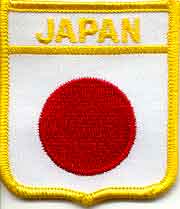|
Japan - Part 4
How would you like to visit a spot where deer roam freely through the
streets, and three or four of them come up to you in every block, beg for
food and permit you to pet them? Add to that scene a
couple of kids who have brought left-over pancakes and bread to feed them
and find four of them come up to you in every block, beg for
food and permit you to pet them? Add to that scene a
couple of kids who have brought left-over pancakes and bread to feed them
and find
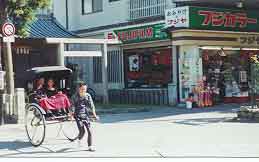 themselves suddenly surrounded by a DOZEN deer. We did that
on the little island of Miajima and we had one continuous, day-long laugh.
The island houses an extensive Shinto Temple (complex) with shrines and
temples all over its mountain. But it is most famous for its magnificent
"floating" torii (gate) which sits in water when
the tide is in and which you can walk to when the tide is out.
Because it is a sacred island, even though people live there year
round, they are not permitted to die there, nor are women permitted to
give birth there. Go figure. themselves suddenly surrounded by a DOZEN deer. We did that
on the little island of Miajima and we had one continuous, day-long laugh.
The island houses an extensive Shinto Temple (complex) with shrines and
temples all over its mountain. But it is most famous for its magnificent
"floating" torii (gate) which sits in water when
the tide is in and which you can walk to when the tide is out.
Because it is a sacred island, even though people live there year
round, they are not permitted to die there, nor are women permitted to
give birth there. Go figure.
Having experienced a cultural exchange at a Japanese home, we have now
experienced one where Japanese families came to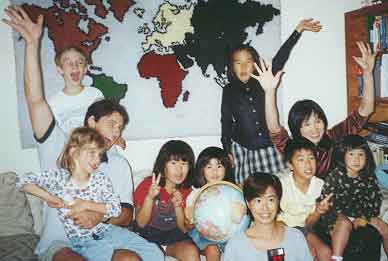 us. At the Japanese
home, the children set the pace for playing fairly quiet and gentle.
But here, Allie set the pace and we had a zoo. It was fun to watch.
Five Japanese children came with two mothers (this night). Rich and
Alisa have a ten-foot trampoline and the five little girls jumped on it
most of the night. Nick and the boy disappeared upstairs and played
games with Nick's collection of Pokemon cards. The oldest girl had
just turned nine, so Rich had baked an angel food cake with strawberry
icing. Three of the kids didn't even touch their piece of cake. Too
sweet! us. At the Japanese
home, the children set the pace for playing fairly quiet and gentle.
But here, Allie set the pace and we had a zoo. It was fun to watch.
Five Japanese children came with two mothers (this night). Rich and
Alisa have a ten-foot trampoline and the five little girls jumped on it
most of the night. Nick and the boy disappeared upstairs and played
games with Nick's collection of Pokemon cards. The oldest girl had
just turned nine, so Rich had baked an angel food cake with strawberry
icing. Three of the kids didn't even touch their piece of cake. Too
sweet!
One day when Alisa was at work and both children were in school, Rich
drove Bob and me to Seven Falls Park, an hour and a half through the
mountainous countryside. Mountains all the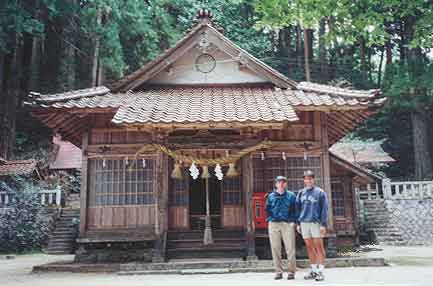 way. It sort of
reminded me of West Virginia except the mountains are steeper and,
therefore, closer together. Perhaps three to five of these mountains
could fit into the area or space of ONE W.V. mountain. The W. V.
mountains are well worn and rounded so people build houses on them.
In contrast, the Japanese mountains are sharper, more crumbly, and it is
rare that anyone puts a house on one. They have too many landslides
here. I was told this is the case throughout Japan. way. It sort of
reminded me of West Virginia except the mountains are steeper and,
therefore, closer together. Perhaps three to five of these mountains
could fit into the area or space of ONE W.V. mountain. The W. V.
mountains are well worn and rounded so people build houses on them.
In contrast, the Japanese mountains are sharper, more crumbly, and it is
rare that anyone puts a house on one. They have too many landslides
here. I was told this is the case throughout Japan.

Seven Falls Park is incredibly beautiful! A Shinto Shrine sits on
the side of a hill in the midst of a grove of two-hundred-year-old temple
trees. Back in Rockville, I planted a Japanese Temple tree off my
kitchen patio thirty years ago. The aura of these trees is one of
peace, quiet, calm and serenity. For those of you who have visited
our home, if you thought OUR tree was lovely, just imagine a whole forest
of really OLD ones.
Last Friday night, we attended the 224th Navy Birthday Ball with Alisa and
Rich. Since Bob doesn't like to dance and I don't like loud music,
Alisa took us home after dinner and speeches as the band started to crank
up.
Japan - Part 5
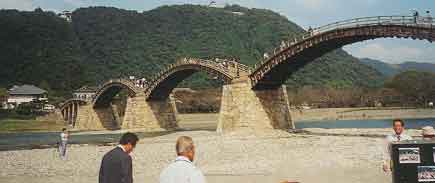 Because some have asked, the U.S. Marine Air Base is situated on an
inland sea at the mouth of the Nishiki River which snakes through the
little city of Iwakuni, up into the mountains on the southern most island
of Honshu, thirty minutes south of Hiroshima. At the far end of the city,
at the base of the mountains, the river is still wide and spanned by the
famous Kintai Bridge, originally built in 1673. It's considered to be one
of the most beautiful bridges in Japan, built of five wooden arches which
sit on high stone abutments. These five arches are what make the bridge so
beautiful and fun to cross. It's like going over five bridges. Because some have asked, the U.S. Marine Air Base is situated on an
inland sea at the mouth of the Nishiki River which snakes through the
little city of Iwakuni, up into the mountains on the southern most island
of Honshu, thirty minutes south of Hiroshima. At the far end of the city,
at the base of the mountains, the river is still wide and spanned by the
famous Kintai Bridge, originally built in 1673. It's considered to be one
of the most beautiful bridges in Japan, built of five wooden arches which
sit on high stone abutments. These five arches are what make the bridge so
beautiful and fun to cross. It's like going over five bridges.
At the far end of the bridge and at the base of Mt. Shiroyama, is Kikko
Park with its gardens, ponds, fountains, a shrine, a couple museums,
restaurants, shops, etc. It must be a sight to behold in the spring with
all the cherry blossoms in bloom. Truly, this is a nature-lover's delight.
At the top of Mt. Shiroyama sits the Iwakuni Castle. Well, it's a
castle by Japanese standards. We might call it a large seven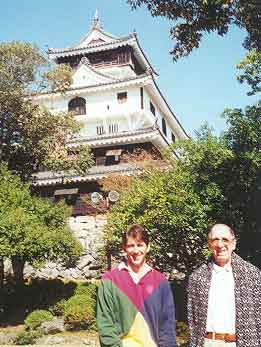 -story
house...an elegant house, for sure! To get to the castle, one takes a tram
up the mountain, then walks up through a beautiful wooded nature preserve
to the castle. After climbing up seven stories of the castle, you have a
spectacular 360-degree view of mountain ranges on one side and on the
other side, the city, river, air base and inland sea. Awesome! Already, we
have been here twice and I hope we can do it one more time as there is
still so much to see. -story
house...an elegant house, for sure! To get to the castle, one takes a tram
up the mountain, then walks up through a beautiful wooded nature preserve
to the castle. After climbing up seven stories of the castle, you have a
spectacular 360-degree view of mountain ranges on one side and on the
other side, the city, river, air base and inland sea. Awesome! Already, we
have been here twice and I hope we can do it one more time as there is
still so much to see.
In addition to the white snakes, a strange little phenomena exists in
the area. Stone dolls! Now, they are only about half an inch high, but
they look like tiny little people dressed in kimonos. They are a
conglomerate of wee tiny black pebbles and sand, collected by an insect of
a mole cricket family. Local artists collect them and do a very Japanese
"thing" to them. They arrange the dolls in groups standing on
an appropriate rock, glue them in place, encase them in a square glass box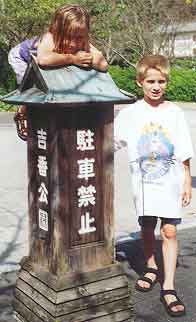 and sell them to tourists. Or, they take a small square piece of white
cardboard, paint a picture on it (usually the Kintai Bridge), glue the
dolls into the scene, place a clear plastic piece over the little frame
for a smaller, more compact and cheaper example for tourists like me with
limited funds and suitcase space. And, yes, of course, I'm bringing one
home with me. I plan to carry it around with me until everyone has seen
it. I am totally fascinated with them. I hope you will be too.
and sell them to tourists. Or, they take a small square piece of white
cardboard, paint a picture on it (usually the Kintai Bridge), glue the
dolls into the scene, place a clear plastic piece over the little frame
for a smaller, more compact and cheaper example for tourists like me with
limited funds and suitcase space. And, yes, of course, I'm bringing one
home with me. I plan to carry it around with me until everyone has seen
it. I am totally fascinated with them. I hope you will be too.
Japan - Part 6
Now that we are back home in Maryland, I would be remiss if I did not
have one final wrap up on our memories of Japan. It came as no surprise
that they drive on the left side of the road, that there are ornamental
gardens in place of yards around their homes, and that the people are
gentle, polite, gracious, dignified, fun-loving, and very civilized.
Furthermore, it is common knowledge that, where in the U.S. they make up
dumb blonde jokes, in Japan we receive a lot of attention, respect, and
get our pictures taken when we aren't looking...a lot! Yes, even little
old ladies like myself.
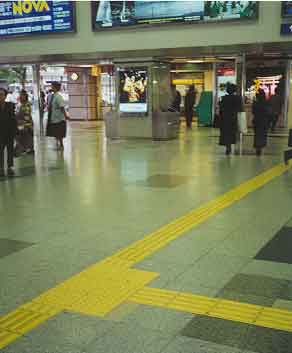 But there are other things that, at a glance, make Japan unique. They
actually pave over the sides of some mountains that threaten to drop rocks
on houses or roads and cars below. You find a yellow, twelve-inch Braille tile
strip down the middle of most sidewalks, so the blind can feel their way
with their canes (why don't WE have that?). Coreopsis grow all along the
highways instead of dandelions. Children not only wear identical school
uniforms, but they all wear their hair in identical short bobs creating
the effect, at a glance, that entire classes have been cloned. But there are other things that, at a glance, make Japan unique. They
actually pave over the sides of some mountains that threaten to drop rocks
on houses or roads and cars below. You find a yellow, twelve-inch Braille tile
strip down the middle of most sidewalks, so the blind can feel their way
with their canes (why don't WE have that?). Coreopsis grow all along the
highways instead of dandelions. Children not only wear identical school
uniforms, but they all wear their hair in identical short bobs creating
the effect, at a glance, that entire classes have been cloned.
And then there is their interesting approach to road and highway
construction. You know the guy who stands in front of a road crew waving
that flag to warn us motorists that there are live people working here?
Well, in Japan, they have designed a life-sized, plastic mechanical
flagman which, seen from a distance, looks just like a real flagman
wearing the same clothes, etc., and he waves a cloth flag up and down.
(And why don't WE do that?) But, get THIS: pretty purple backhoes and
pink cement mixers. And why not? It certainly is fun to see them and
brought a smile to MY face.
Oh yes, Halloween was really a hoot! On the marine air base, an
American family is only permitted to bring TEN Japanese guests on base at
a time. This is because one year someone invited an entire Japanese
neighborhood (I can't remember if Rich said 75 or 100 or 150), and they
had Japanese running all over the place. This made security very nervous.
So now, Rich and Alisa had to be very selective, who they invited. These
kids (of their acquaintance), had never experienced the Halloween game. The
little girls were all dressed up in princess costumes (one came as an
American Indian princess) and the boys wore regular clothes and put on
masks (ironically, Nick went as a full-costumed Ninja). On base, they were
only permitted to go trick-or-treating between the hours of 6:00 and 8:00
pm. (One of the advantages of being military). I think they were pretty
excited about it and really enjoyed themselves. I know WE did!
One of the greatest aspects of our trip was that we went out to dinner about five meals a week. Only four meals were in restaurants on
base; all the other meals were in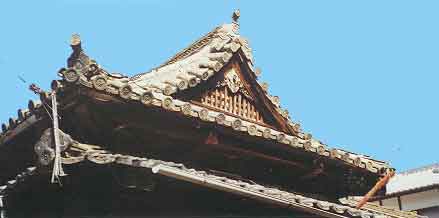 Japanese restaurants. And those
restaurants ranged from the Japanese equivalent of a deli and a McDonald's (where Nick and Allie could practice ordering in Japanese), to
the finest, most elegant, the Sans Zoku. The Sans Zoku is a chain which
constructs authentic looking Japanese "castles", complete with
what appears to be (I'm sure it isn't) antique furnishings and art
objects. The one where we dined was situated next to a mountain stream
complete with beautiful gardens, bridges, lanterns ... and the
"tourist trap" arts and crafts booths outside. Who cares! It was
lovely! Japanese restaurants. And those
restaurants ranged from the Japanese equivalent of a deli and a McDonald's (where Nick and Allie could practice ordering in Japanese), to
the finest, most elegant, the Sans Zoku. The Sans Zoku is a chain which
constructs authentic looking Japanese "castles", complete with
what appears to be (I'm sure it isn't) antique furnishings and art
objects. The one where we dined was situated next to a mountain stream
complete with beautiful gardens, bridges, lanterns ... and the
"tourist trap" arts and crafts booths outside. Who cares! It was
lovely!
One night, we were taken to a very fine restaurant by one of Rich's
students. We had our own private room upstairs. You know, the kind you see
in the movies; small enough to be intimate but large enough for five kids
to run around the table, if we had permitted, -- an enjoyable and very
memorable evening, to be sure.
Just before we returned home to Rockville, two more of Richard's
students sent gifts to Bob and me. I cannot express how touched I was by
these gestures. They had already been so kind to us, it really wasn't
necessary. But Rich tells us that is the way of their hospitality.
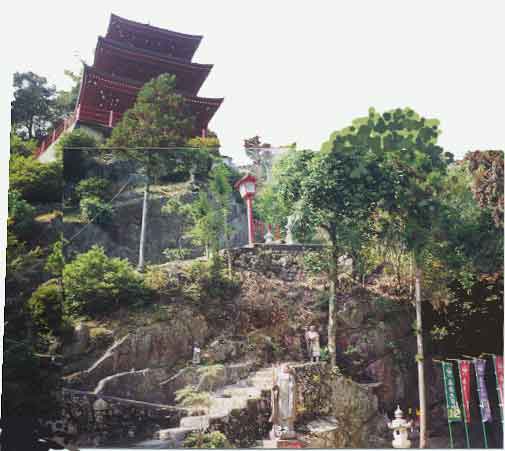 Just before we left, Rich took us to one of the most peaceful places I
have ever been; a Buddhist Temple on the outskirts of Iwakuni. It's a
place he sometimes goes to study or meditate or just sit and be. Of course
there is the usual stream trickling through the area. It was very quiet -
no people. We walked a little way up the mountain, past the usual statues
and little shrines with vases of flowers amidst the ragged rocks and
evergreens. It wasn't a very large area, but large enough to contain a
couple temples. But when we arrived at the point where we stopped, we were
high enough to view part of Iwakuni. But it was the peace that dominated.
I think I shall never forget this one little spot in the world, and I
shall return there again and again, in my mind, to experience the peace
of that moment. Thank you, Richard! Just before we left, Rich took us to one of the most peaceful places I
have ever been; a Buddhist Temple on the outskirts of Iwakuni. It's a
place he sometimes goes to study or meditate or just sit and be. Of course
there is the usual stream trickling through the area. It was very quiet -
no people. We walked a little way up the mountain, past the usual statues
and little shrines with vases of flowers amidst the ragged rocks and
evergreens. It wasn't a very large area, but large enough to contain a
couple temples. But when we arrived at the point where we stopped, we were
high enough to view part of Iwakuni. But it was the peace that dominated.
I think I shall never forget this one little spot in the world, and I
shall return there again and again, in my mind, to experience the peace
of that moment. Thank you, Richard!
Return to:
Iwakuni, Japan by
Vicky Blitz (Parts 1-3)
Japan main page
THINK GLOBALLY - ACT LOCALLY - PRAY FOR WORLD PEACE
|
